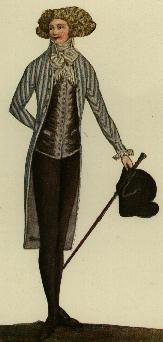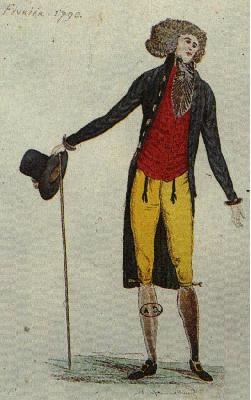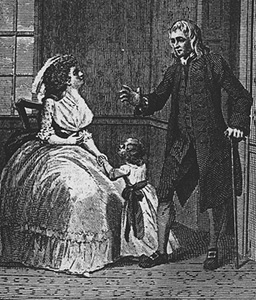

Male Dress, 1790. Check out how tight the pants are in this fashion plate! I love the jacket as well.
February 25, 1790. It is difficult to see, but the waistcoat here is spangled.
See also the ten images of real men's clothing from 1790-1825 on the Real Regency Clothing Page, including two men's nightgowns.
You may find the Jane Austen Bulletin Board: Postings from Male Fashions interesting.
See also David's Portrait of Monsieur Mongez, 1812 and Portrait of the Count de Turenne, 1816
These striped men's coats are characteristic of the 1790s. Such striped fabric was copied by women, especially in France in 1793-5. Compare to the green and gold French Frock Coat, 1793 and two-tone gold striped Men's Redingote, habit dégagé, c. 1796-1798.
|
|
Male Dress, 1790. Check out how tight the pants are in this fashion plate! I love the jacket as well. | February 25, 1790. It is difficult to see, but the waistcoat here is spangled. |
|
|
April 15, 1790, Plate 1. Issue no. 6. Giuliana Chesne Dauphiné Griffo describes this plate as: "Young aristocrat wearing a dress of `semi-mourning,' indicating a partial converion to the constitution, but also in remebrance of past times--a style know as `en demi-deuil.'" | April 25, 1790, Plate 1. Issue no. 7. Giuliana Chesne Dauphiné Griffo describes this plate as: "Officer's uniform with gilded brass buttons depicting the city's arms and the number of his division and battalion." |
|
|
May 5, 1790, Plate 1. Issue no. 8. Giuliana Chesne Dauphiné Griffo describes this plate as: "Uniform of a city councillor, whose hair is dressed `à l'conseillè,' wearing a sah in nationalist colors and carrying a report of the National Assembly sessions." | June 15, 1790, Plate 1. Issue no. 7. Male dress à l'anglaise. |

July 1790, "A beautiful historical Picture of the Little Pleader."
From the June 1791 issue, descriptions of court dresses for men:
The king, as usual on his own birth-day, in a plain suit of scarlet clothes.
His royal highness the prince of Wales, in a green striped silk coat, embroidered in a most superb manner with gold and silver spangles all over, the waistcoat of white silk, covered over with silver tissue, and a small embroidery to correspond with the coat; breeches the same as the coat. His highness wore a most brilliant star, George, sword and epaulet, both at the drawing room and ball.
Duke of Clarence, in a full navy uniform, with a brilliant star of the order of St. Andrew. His highness wore a most elegant diamond loop across his shoulder.
Duke of Gloucester, in full regimental uniform.
Prince William of Gloucester, a striped nut-brown coat and breeches, with a light embroidery of flowers, the waistcoat of silver tissue, and embroidered to correspond with the coat.
Duke of Leeds, a dark brown coat and breeches, with a narrow embroidery of flowers, the waistcoat white, to join with the colour of the coat. Duke of Bedfored, the most suberb dress at court; the colour of the coat and breeches could not be distinguished by the eye, being so richly covered all over with silver spangles, over which was a very rich embroidery of gold and silver intermixed, the waistcoat white and silver tissue, his buckles set round with diamonds. Duke of Montrose, a light green striped silk coat and breeches, with a very rich embroidery of silver spangles. Duke of Dorset, a carbeaue and blue striped coat and breeches, with white silk waistcoat embroidered with silver spangles; the waistcoat embroidered to correspond with the coat. Duke of Queensberry, a plain green striped silk coat, waistcoat and breeches. The Spanish ambassador, one of the neatest dresses at court; his coat and breeches were embroidered and spotted all over with silver; the waistcoat of white silk embroidered.